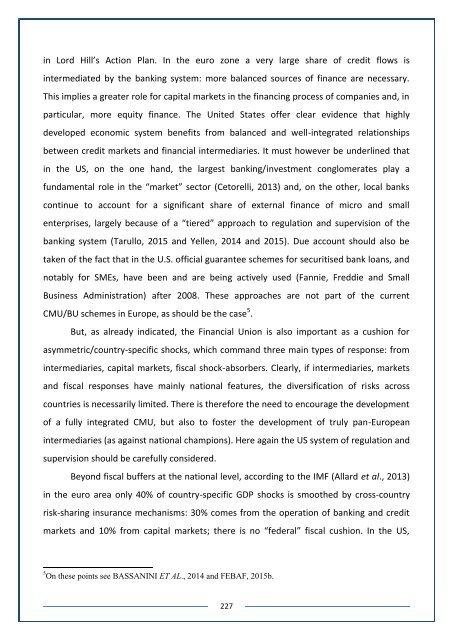ECONOMICS YEARLY REVIEW
Law_and_Economics_Yearly_Review_LEYR_Journal_vol_4_part_2_2015
Law_and_Economics_Yearly_Review_LEYR_Journal_vol_4_part_2_2015
Create successful ePaper yourself
Turn your PDF publications into a flip-book with our unique Google optimized e-Paper software.
in Lord Hill’s Action Plan. In the euro zone a very large share of credit flows is<br />
intermediated by the banking system: more balanced sources of finance are necessary.<br />
This implies a greater role for capital markets in the financing process of companies and, in<br />
particular, more equity finance. The United States offer clear evidence that highly<br />
developed economic system benefits from balanced and well-integrated relationships<br />
between credit markets and financial intermediaries. It must however be underlined that<br />
in the US, on the one hand, the largest banking/investment conglomerates play a<br />
fundamental role in the “market” sector (Cetorelli, 2013) and, on the other, local banks<br />
continue to account for a significant share of external finance of micro and small<br />
enterprises, largely because of a “tiered” approach to regulation and supervision of the<br />
banking system (Tarullo, 2015 and Yellen, 2014 and 2015). Due account should also be<br />
taken of the fact that in the U.S. official guarantee schemes for securitised bank loans, and<br />
notably for SMEs, have been and are being actively used (Fannie, Freddie and Small<br />
Business Administration) after 2008. These approaches are not part of the current<br />
CMU/BU schemes in Europe, as should be the case 5 .<br />
But, as already indicated, the Financial Union is also important as a cushion for<br />
asymmetric/country-specific shocks, which command three main types of response: from<br />
intermediaries, capital markets, fiscal shock-absorbers. Clearly, if intermediaries, markets<br />
and fiscal responses have mainly national features, the diversification of risks across<br />
countries is necessarily limited. There is therefore the need to encourage the development<br />
of a fully integrated CMU, but also to foster the development of truly pan-European<br />
intermediaries (as against national champions). Here again the US system of regulation and<br />
supervision should be carefully considered.<br />
Beyond fiscal buffers at the national level, according to the IMF (Allard et al., 2013)<br />
in the euro area only 40% of country-specific GDP shocks is smoothed by cross-country<br />
risk-sharing insurance mechanisms: 30% comes from the operation of banking and credit<br />
markets and 10% from capital markets; there is no “federal” fiscal cushion. In the US,<br />
5 On these points see BASSANINI ET AL., 2014 and FEBAF, 2015b.<br />
227


